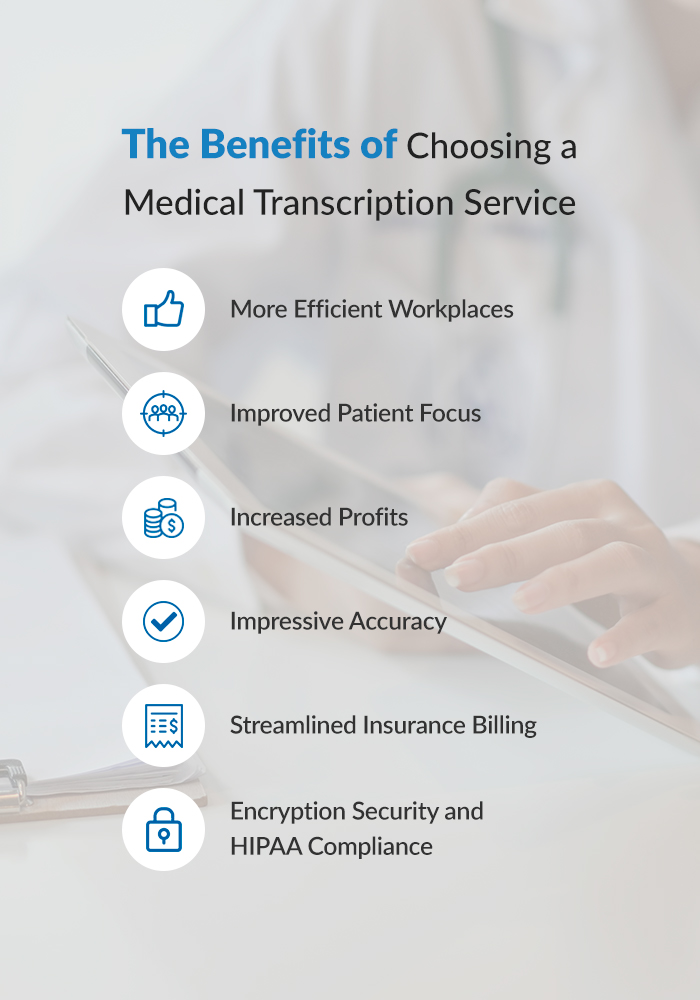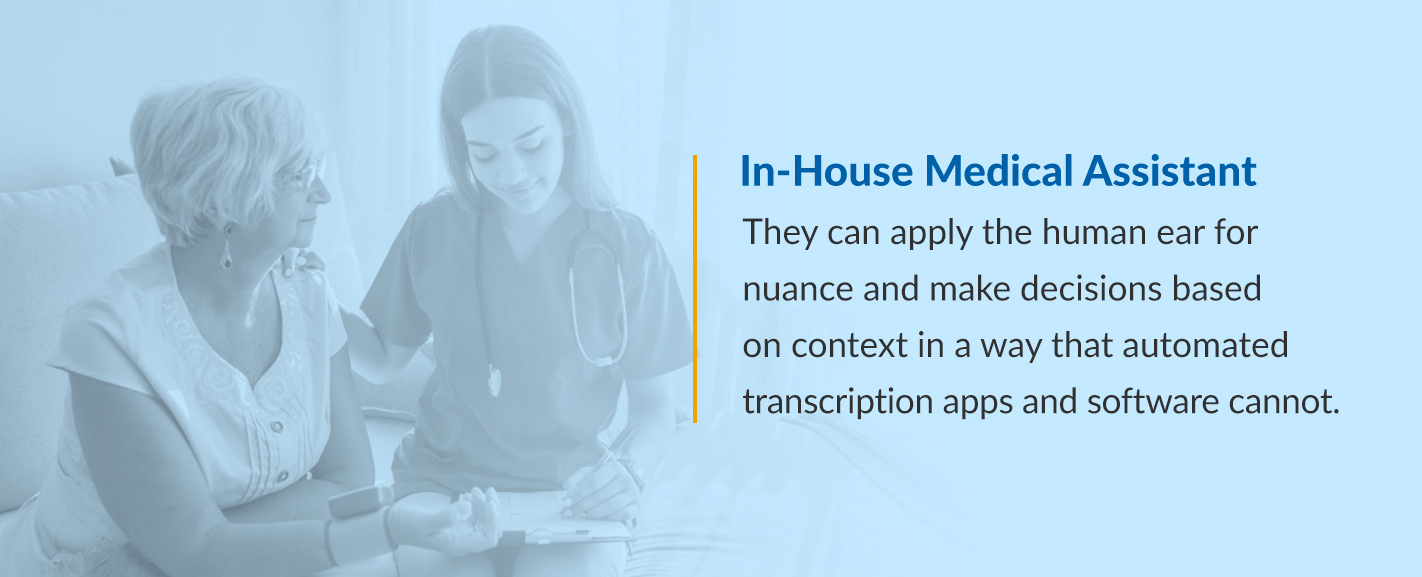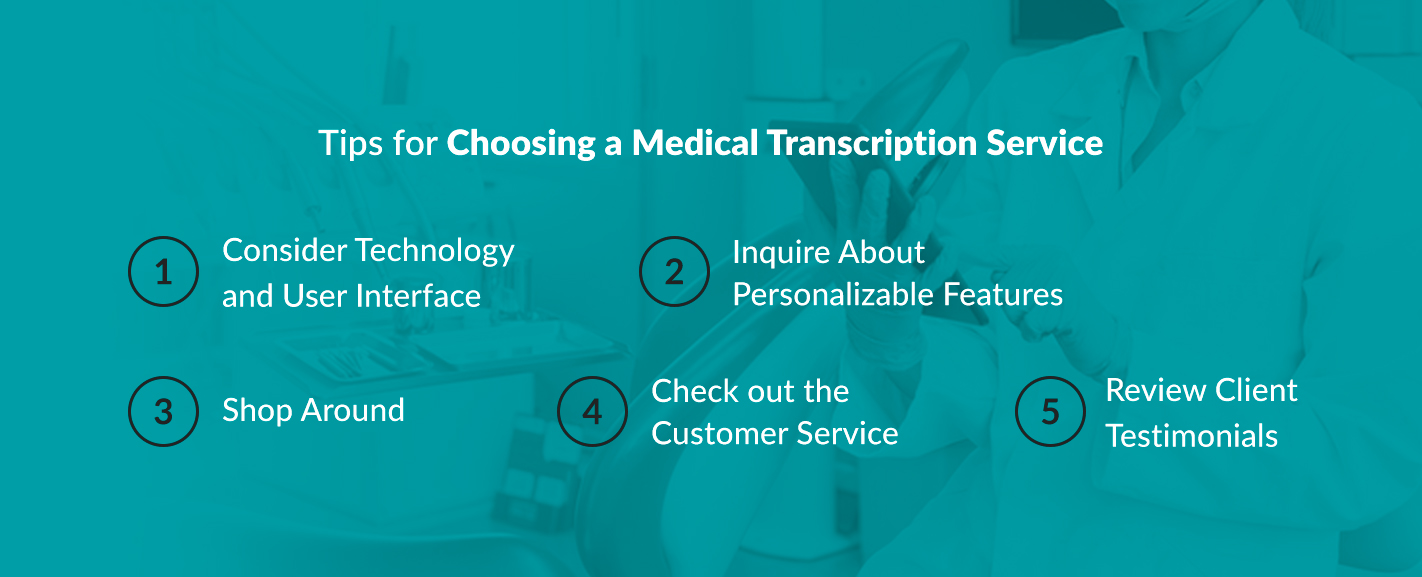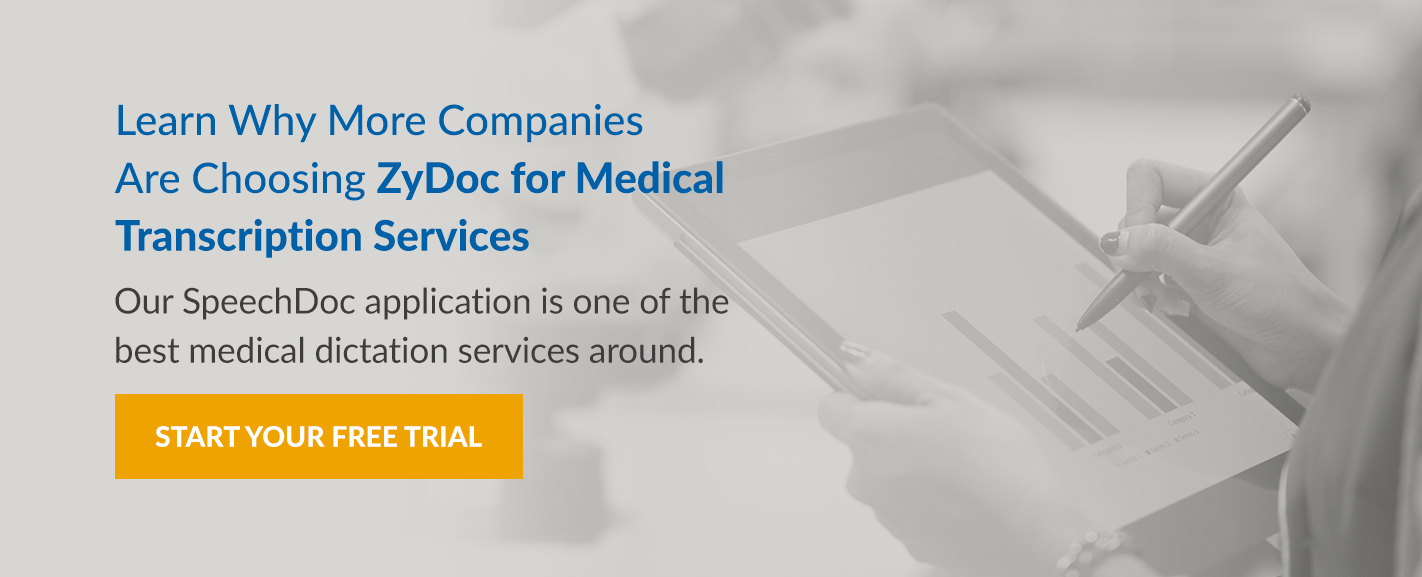How to Choose Medical Transcription Services
Oct 10, 2019 | Jonathan Maisel
There’s no doubt that transcription services benefit medical practices immensely. They remove data-entry work from practitioners’ plates, allowing physicians and other health care professionals to focus their energies on the practice of medicine.
For many practices, especially those with a high volume of transcription reports, outsourcing the work can be a huge relief. But when you’re trying to decide on transcription services, you may feel uncertain about how to tell which company is right for you.
Fortunately, this guide is here to help. Follow the tips below to choose the best medical transcription services for your professional needs.

The Benefits of Choosing a Medical Transcription Service
Medical transcription services offer invaluable services to medical practices of every stripe.
1. More Efficient Workplaces
The primary benefit of medical transcription services for many offices is that it frees up doctors’ and nurse practitioners’ valuable time, often substantial blocks of hours per week.
One study found that primary care physicians at the University of Wisconsin’s medical school spend up to two hours updating patients’ electronic medical records (EMRs) for every hour they spend providing direct patient care. Additionally, physicians spend almost an hour and a half per day working on EMRs after clinic hours, during what should be their personal time.
Imagine coming home after a long, stressful day of treating patients only to have to do another hour and a half of desk work while your family, friends, pets, books, TV shows and fun outdoor adventures are beckoning. Medical transcription services help with this issue by taking the burden of some of this work off health care professionals’ shoulders.
2. Improved Patient Focus
Because medical professionals spend so much time on data entry and transcription work, they often struggle to make time to focus on what’s at the heart of their practice — helping patients.
The more desk work that medical professionals can outsource, the more time they can spend listening to patients, thoughtfully considering each case and coming up with an accurate diagnosis and effective treatment plan. That’s a win-win situation for both practitioners and patients. It gives patients the quality care they need and improves practitioners’ job satisfaction and retention within the medical field.
3. Increased Profits
When health care professionals are relieved of the burden of transcription work, they can make and keep more appointments. Thus they see more patients and bring more money into their practices.
Additionally, because transcription services are cost-effective, they allow hospitals and private practices to save as well. Not having to pay an in-house employee frees up funds. And the low cost — often a few cents per line — of transcription services means that using these services is easy on providers’ budgets.
4. Impressive Accuracy
Trained professional medical transcriptionists bring practiced ears and sharp eyes to their work. They can draw on strong medical training and transcribe even most specialized and complex medical lexicons with ease.
Additionally, many transcription services guarantee their work to an exceptionally high level of accuracy, say 98 or 99%. A tiered system in which an additional professional editor looks over the completed transcriptions helps contribute to the accuracy of the work.
5. Streamlined Insurance Billing
Many insurance companies require detailed levels of documentation before they will cover a claim. With a professional medical transcription service, you can be sure that the transcription files you get back will be complete, thorough and formatted to insurance companies’ specifications.
6. Encryption Security and HIPAA Compliance
It’s imperative for transcription services to use secure networks and comply with HIPAA privacy requirements. HIPAA specifies the following criteria for website services:
- Transfer encryption: Data must be encrypted when it is transmitted over any network.
- Backup: Data must be backed up and recoverable in the event of a crash or data loss.
- Authorization: Only authorized users who provide correct, unique credentials may access data.
- Integrity: Data cannot be changed or tampered with.
- Storage encryption: Data should be encrypted for storage or archival purposes.
- Disposal: Data must undergo permanent erasure when no longer needed.
- Sharing: If data is stored on third-party servers, the third-party entity must sign a HIPAA agreement and comply with HIPAA regulations.
Reputable transcription companies comply with all these requirements. They typically use at least 128-bit encryption to ensure the security of patient data. Additionally, medical transcription services perform background checks on their staff to ensure that only vetted, reliable employees work on medically sensitive documents.

In-House Transcription vs. Medical Transcription Services
When medical practices are figuring out how to accomplish their transcription work, they have a few different options.
1. Voice-Recognition Apps or Software
With this technology, medical professionals speak into their phones or laptops, and the app or software automatically converts their speech into text format. Though this automated transcription option may sound appealing because it’s quick and affordable, it also comes with substantial drawbacks. The biggest of these is that voice-to-text applications are notorious for making errors — and that’s with simple, recognizable, conversational, everyday speech.
Imagine the errors that occur when the speech in question contains the unfamiliar and extremely specialized vocabulary of the medical profession. Additionally, when errors occur, they can have serious adverse effects on health outcomes and even on life-or-death situations. It’s easy to see why most health care professionals and practices decide to choose another route for their transcription needs.
2. In-House Medical Assistant
In-house medical assistants help solve the issues that come along with automated transcription. They can apply the human ear for nuance and make decisions based on context in a way that automated transcription apps and software cannot.
Yet employing an in-house medical assistant for transcription work also comes with its drawbacks. For one thing, a medical assistant may have only limited proficiency with medical terminology. So even though the rate of errors may decrease in comparison to automated services, a few errors may still creep into the transcription work. The possibility of mistakes in the work means one of two things: Either patients will have potentially life-threatening errors in their charts, or physicians and nurse practitioners must spend time poring over completed transcriptions to ensure accuracy. Neither option is ideal.
Employing a full-time in-house assistant can also strain a medical practice’s funds. A medical assistant needs a salary that’s adequate to live on, typically almost $35,000 to year depending on the cost of living. Health care and other benefits put pressure on a clinic’s budget as well. Taking time out of other staff members’ days to hire and train assistants and deal with turnover also adds unnecessary pressure, especially in a small office.
Even if a medical assistant is well trained and competent, this person can work only so fast and so accurately. The medical assistant most likely attends to other office duties in addition to transcription tasks. This situation can cause a backlog when there is only one employee to handle the work.
3. In-House Professional Transcriptionist
Like an in-house medical assistant, an in-house transcriptionist provides several benefits. By listening carefully to audio recordings, medical transcriptionists avoid the nonsensical renderings that plague automated transcriptions. In addition, professional transcriptionists are typically trained in medical terminology and familiar with medical procedures. These employees are likely to hear and transcribe even hyper-specialized medical vocabulary correctly because they understand its meaning and context.
As with medical assistants, the median salary for medical transcriptionists is almost $35,000 a year, and health care and other benefits require additional funding from the medical practice. Additionally, transcriptionists often need higher pay because of their comprehensive medical knowledge and job skills. So the costs of hiring professional in-house medical transcriptionists can be prohibitive.
4. Medical Transcription Services
Medical transcription services are an ideal choice for many medical practices because they offer the best of both worlds.
Like basic automated transcription, medical transcription services offer a quick turnaround time. STAT turnaround times for rush jobs are often available for a small fee. Medical transcription services are also extremely cost-effective. When you use a medical transcription service, there’s no need to pay a salary and benefits to a single person. The transcription company takes care of that. Most medical transcription services offer prices that come out to a few cents per line.
Additionally, medical transcription services offer the benefits of human cognition and perception. Because trained staff members work on the transcription, their ears pick up on the nuance that voice-recognition programs often get hilariously wrong. This human element leads to a substantial reduction in errors. The team-centered nature of professional transcription services leads to a reduction in errors as well, with more than one set of eyes and ears looking over each project.

Tips for Choosing a Medical Transcription Service
When you’re looking for a medical transcription service, here are a few factors it’s essential to keep in mind.
1. Consider Technology and User Interface
Accuracy and turnaround speed are essential, of course. But it’s also important to choose a service that has offers the latest technology. You don’t want your transcription workflow to be interrupted because the service’s technology is slow or requires an upgrade.
The technology and user interface should also be intuitive so health care staff members can use it efficiently, with a minimum of stress.
2. Shop Around
When you’re considering a service that can dramatically improve the efficiency and workflow of your practice, it’s worth spending some time investigating the options. Shop around with different companies. Some medical transcription services — ZyDoc among them — offer a short free trial so that clinics can test-drive the service without financial risk.
It’s always a great sign when companies are willing to offer free trials. You get free services, but the offer also means the company is confident in its services. It’s willing to bet that after the trial period is over, you’ll love the product so much that you’ll gladly pay for more.
As you shop, compare prices, but be sure you’re comparing prices directly. Make sure that the cheaper-looking service doesn’t come with any hidden fees.
3. Inquire About Personalizable Features
In your search, ensure that you can personalize the service for your needs and workload.
Sometimes, for routine office visits, your office may need only a basic level of quality transcription service. At other times, with a complicated procedure or in emergencies, you may need the highest possible level of guaranteed accuracy, even if it costs a little more. A transcription service that allows you the flexibility to personalize in this way is likely to meet more of your needs over the long term.
4. Check out the Customer Service
Send a few emails or make a few phone calls to support staff. See if the staff members are helpful and easy to work with. If you speak to a representative who seems more interested in pushing particular services than in genuinely answering your questions, this is a sign that you may want to look elsewhere. On the other hand, if customer service representatives are friendly, knowledgeable and quick to respond, you may have found the right place.
5. Review Client Testimonials
Client testimonials can be a great way to get a feel for customer satisfaction. Of course, company websites may only feature flattering, five-star testimonials that paint them in an excellent light. However, positive customer testimonials still attest to a high level of customer satisfaction. You can also turn to online services for more reviews.
What to Look for in a Medical Transcription Service
So now you have an idea of how to search for a medical transcription service. But as you’re searching, what should you be looking for?
1. Compatibility With Your EMR System
The best medical transcription software is compatible with your EMR system. The fastest, most accurate transcription service in the world is of little use to you if the service is not compatible with the system you use for your EMRs. Make sure you verify compatibility, potentially with a free trial of the service, before committing.
2. Strong Technical Support
A transcription service may boast a suite of attractive, high-tech features, but if something goes wrong, are there staff on hand who are ready to assist with technical difficulties? You don’t want to end up doing mountains of transcription because something went wrong and no one was available to help you get back on track.
3. Security and HIPAA Compliance
Security and HIPAA compliance are absolutely crucial to any medical transcription service because they ensure the confidentiality of sensitive patient data. The National Institute of Standards and Technology recommends at least 128-bit encryption for the staunchest level of protection.
4. A Variety of Dictation Options
Many medical transcription services offer a variety of ways to deliver dictation. For example, you may record dictation with a dedicated smartphone app or upload an audio file from a handheld voice recorder. Some services even accept dictation over the phone. Think about which options would work best for your particular practice.
5. A Convenient Document Management System
In the document management system that a medical transcription service uses, check to see if doctors can edit online and sign electronically without printing out reams of paper. Look for a system that can provide easy, secure solutions to common issues.
6. Cloud Backup and Storage
Cloud-based backup systems provide an extra layer of protection against loss in the event of a system crash. A secure backup system also helps comply with HIPAA standards. Ideally, the backup service provided will be free.
7. Quality Control
By the time files come back to your practice, more than one person’s eyes should have seen them. Ideally, a transcriptionist will do the work, and then an editor will check it. That way, fewer errors will slip into the final file. Though it’s always wise for physicians or nurse practitioners to triple-check the final product themselves, a quality control system makes their jobs much quicker and easier.
8. Convenient Transcription Uploading
Some medical transcription services can upload the completed transcription file directly into the patient’s EMR. With other services, you may have to copy and paste the information into each patient’s EMR. Determine which level of service works best for the needs of your practice.

Learn Why More Companies Are Choosing ZyDoc for Medical Transcription Services
Browse our website to learn about the valuable transcription services we offer and to start your free trial. Our services offer a robust quality control system and a rigorous adherence to HIPAA requirements. We also guarantee near 100% accuracy and provide a variety of convenient features to make uploading and receiving your files as easy as possible. Our SpeechDoc application is one of the best medical dictation services around.
ZyDoc has several pricing options available that can work for any budget, so medical practices should feel free to choose the option that works best for them. Get in touch today.
